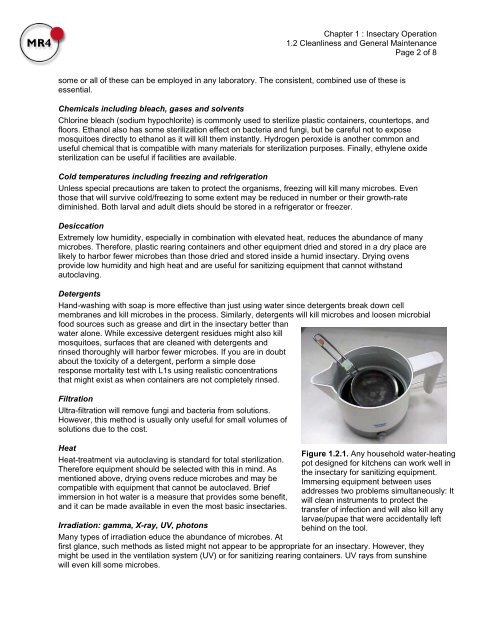Methods in Anopheles Research - MR4
Methods in Anopheles Research - MR4
Methods in Anopheles Research - MR4
- No tags were found...
Create successful ePaper yourself
Turn your PDF publications into a flip-book with our unique Google optimized e-Paper software.
Chapter 1 : Insectary Operation1.2 Cleanl<strong>in</strong>ess and General Ma<strong>in</strong>tenancePage 2 of 8some or all of these can be employed <strong>in</strong> any laboratory. The consistent, comb<strong>in</strong>ed use of these isessential.Chemicals <strong>in</strong>clud<strong>in</strong>g bleach, gases and solventsChlor<strong>in</strong>e bleach (sodium hypochlorite) is commonly used to sterilize plastic conta<strong>in</strong>ers, countertops, andfloors. Ethanol also has some sterilization effect on bacteria and fungi, but be careful not to exposemosquitoes directly to ethanol as it will kill them <strong>in</strong>stantly. Hydrogen peroxide is another common anduseful chemical that is compatible with many materials for sterilization purposes. F<strong>in</strong>ally, ethylene oxidesterilization can be useful if facilities are available.Cold temperatures <strong>in</strong>clud<strong>in</strong>g freez<strong>in</strong>g and refrigerationUnless special precautions are taken to protect the organisms, freez<strong>in</strong>g will kill many microbes. Eventhose that will survive cold/freez<strong>in</strong>g to some extent may be reduced <strong>in</strong> number or their growth-ratedim<strong>in</strong>ished. Both larval and adult diets should be stored <strong>in</strong> a refrigerator or freezer.DesiccationExtremely low humidity, especially <strong>in</strong> comb<strong>in</strong>ation with elevated heat, reduces the abundance of manymicrobes. Therefore, plastic rear<strong>in</strong>g conta<strong>in</strong>ers and other equipment dried and stored <strong>in</strong> a dry place arelikely to harbor fewer microbes than those dried and stored <strong>in</strong>side a humid <strong>in</strong>sectary. Dry<strong>in</strong>g ovensprovide low humidity and high heat and are useful for sanitiz<strong>in</strong>g equipment that cannot withstandautoclav<strong>in</strong>g.DetergentsHand-wash<strong>in</strong>g with soap is more effective than just us<strong>in</strong>g water s<strong>in</strong>ce detergents break down cellmembranes and kill microbes <strong>in</strong> the process. Similarly, detergents will kill microbes and loosen microbialfood sources such as grease and dirt <strong>in</strong> the <strong>in</strong>sectary better thanwater alone. While excessive detergent residues might also killmosquitoes, surfaces that are cleaned with detergents andr<strong>in</strong>sed thoroughly will harbor fewer microbes. If you are <strong>in</strong> doubtabout the toxicity of a detergent, perform a simple doseresponse mortality test with L1s us<strong>in</strong>g realistic concentrationsthat might exist as when conta<strong>in</strong>ers are not completely r<strong>in</strong>sed.FiltrationUltra-filtration will remove fungi and bacteria from solutions.However, this method is usually only useful for small volumes ofsolutions due to the cost.HeatHeat-treatment via autoclav<strong>in</strong>g is standard for total sterilization.Therefore equipment should be selected with this <strong>in</strong> m<strong>in</strong>d. Asmentioned above, dry<strong>in</strong>g ovens reduce microbes and may becompatible with equipment that cannot be autoclaved. Briefimmersion <strong>in</strong> hot water is a measure that provides some benefit,and it can be made available <strong>in</strong> even the most basic <strong>in</strong>sectaries.Irradiation: gamma, X-ray, UV, photonsMany types of irradiation educe the abundance of microbes. AtFigure 1.2.1. Any household water-heat<strong>in</strong>gpot designed for kitchens can work well <strong>in</strong>the <strong>in</strong>sectary for sanitiz<strong>in</strong>g equipment.Immers<strong>in</strong>g equipment between usesaddresses two problems simultaneously: Itwill clean <strong>in</strong>struments to protect thetransfer of <strong>in</strong>fection and will also kill anylarvae/pupae that were accidentally leftbeh<strong>in</strong>d on the tool.first glance, such methods as listed might not appear to be appropriate for an <strong>in</strong>sectary. However, theymight be used <strong>in</strong> the ventilation system (UV) or for sanitiz<strong>in</strong>g rear<strong>in</strong>g conta<strong>in</strong>ers. UV rays from sunsh<strong>in</strong>ewill even kill some microbes.
















